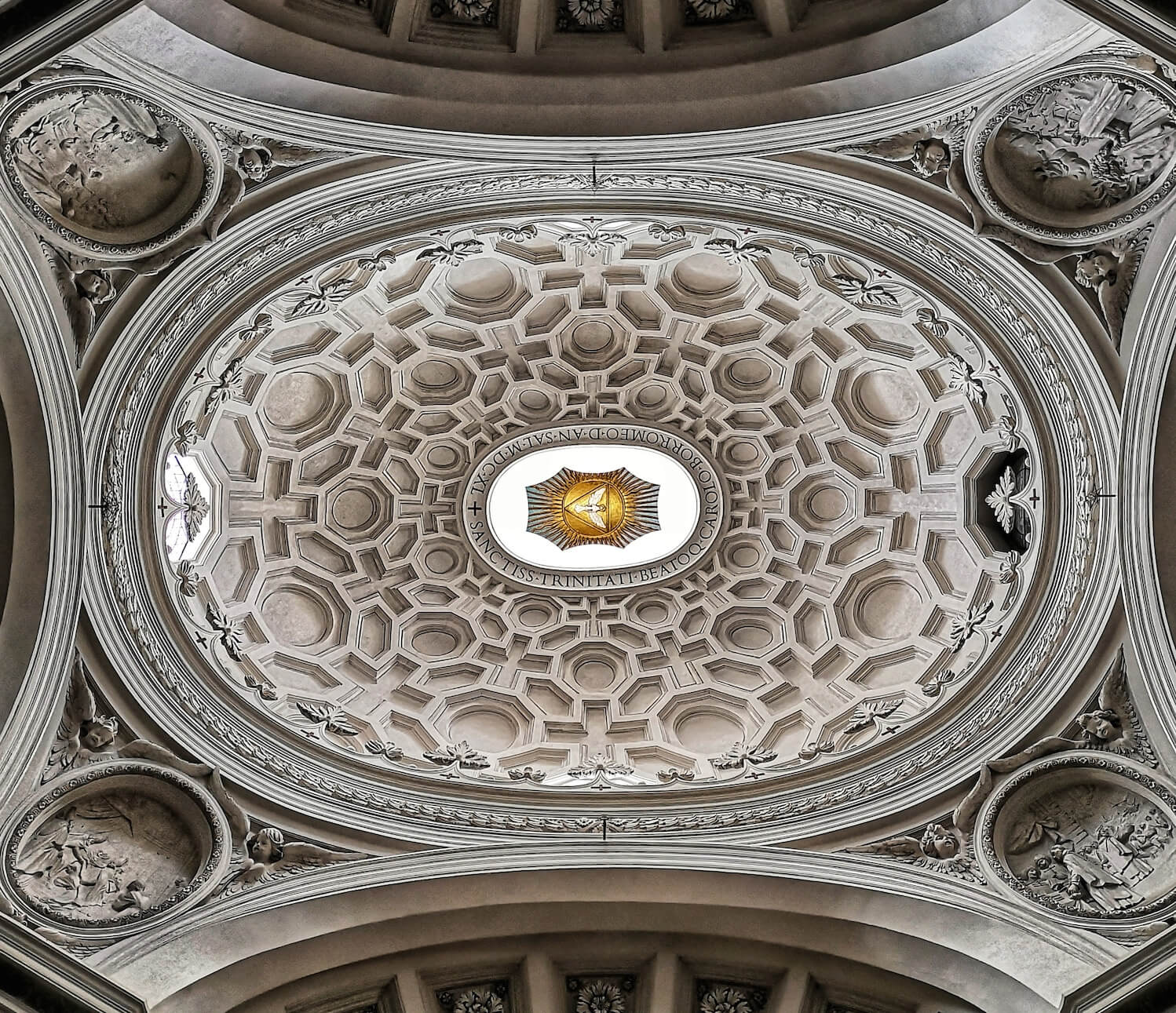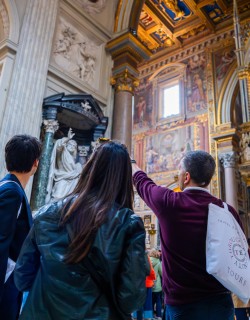
On the 3rd of August 1667, Francesco Borromini committed suicide in a manner more reminiscent of a Shakespearian tragedy than of real life; in the culmination of one of the fits of depression that overcame the architect more and more frequently as his life progressed, Borromini literally fell on his own sword.
But not even this final act of defiance against a world that never truly accepted his irascible personality or idiosyncratic talent went according to plan. Running yourself through with a sword is far more difficult than Shakespeare or the ancient sources would have you think, and Borromini survived his own mortal blow for some hours, even managing to leave behind a first-hand account of the bloody event. The dark clouds of mental illness that precipitated his desperate suicide swirled above this troubled genius for most of his life, and profoundly affected the course of his professional career.

I am standing at one of Rome’s great crossroads, perched on the crest of a hill that plunges down on all four sides to some of the city’s most recognisable landmarks. To the north the obelisk of Trinità dei Monti rises majestically towards the heavens at the top of the Spanish Steps (hidden from our view behind it is another obelisk, that of Piazza del Popolo, a rather grand way of informing travellers that they have finally arrived in the Eternal City); to the south the hulking form of the basilica of Santa Maria Maggiore dominates the distant panorama; to the west towers yet another obelisk, now marking the seat of the Italian presidency at the top of the Quirinal hill, and to the east one can just make out the Porta Pia, the gate designed by Michelangelo in the ancient Aurelian Walls that marked the easternmost extent of the Renaissance city.

It is a fascinating encapsulation of the mind-set of the 16th and 17th century city-planners who were largely responsible for how the city looks today, but not what has brought me to this spot. For wedged on the corner of this important junction is the tiny church of San Carlo alle Quattro Fontane, one of Borromini’s most enduring contributions to Rome’s peerless urban landscape.

Trying to get a good look at this façade, however, is a frustrating experience. So narrow are the roads here that there is simply not enough space to take it all in, literally nowhere to stand. From the only vantage point you are allowed by the narrow street, it is nearly impossible to make sense of this building, and impossible to uncover any architectonic logic behind the myriad shapes before you. It is complex and capricious, and precisely because of this a thing of incredible beauty.
Forced to remain too close to the church, perhaps leaning awkwardly against one the four fountains that gives the crossroads it’s name, one’s impression is of a constantly rippling expanse of stone, undulating and shifting like the waves of the sea, or the sands of the desert. Thick, solid stone walls are treated as if they are made of the softest clay. This is a façade that seems to boldly betrays the sensibilities of a sculptor rather than an engineer.

Is it facile to imagine that we can see the inner workings of an architect’s mind in the structures that he or she creates? Such psycho-biographical analysis has long been out of vogue in serious academic circles, seen as an unwelcome relic of Freud’s pervasive influence on the critical landscape of the twentieth century. We should know better than to be seduced by the romantic fantasy of a troubled genius pouring his psyche out into the fabric of his works like so many pages of his diary. It is, however, extremely difficult to take the intellectual high-ground when confronted with the architectural corpus of this great genius of the Italian baroque.
Entering Borromini’s San Carlino is a dizzying experience. Shapes morph into one another. A convex curve suddenly becomes concave, and it is impossible to determine exactly how or when the transformation took place. The entire façade of this tiny church could fit inside a single supporting pier of St. Peter’s enormous dome, in whose decoration the hand of his great rival Bernini is everywhere apparent. And yet, it is perhaps a church more daring, more innovative than anything even Bernini himself had ever attempted.

Where Bernini combined painting, sculpture and architecture to create complete and unified artistic ensembles like the theatrical stage-sets of St. Peter’s and Santa Maria della Vittoria (perfectly suited to the populist pedagogical concerns of the Counter-Reformation), Borromini integrated sculpture and architecture through a radically different procedure. It is not an exaggeration to say that he literally sculpted with space, carving fabulous sculptures out of the sheer immanence of thin air. Bernini’s religious zeal ensured his position as the Papacy’s favoured architect for much of his career, but the architectural philosophy of Borromini was no less attuned to the project of glorifying God. Indeed, what could be more spiritual, or closer in the eyes of the faithful, to the creative process of the original divine creator than this?

Borromini’s evocation of a higher power’s virtuous conjuring of the firmament is so subtle and spiritual in its way that one need not share the religious frenzy of that bygone era to appreciate it. This is architecture as affect, a place where architectonics and psychology meet. One’s experience of this building is not objective. Your first thoughts are not of stresses, supports and other such practical matters, but rather how we engage with the space we inhabit, how it impacts us, and the infinite possibilities of space itself.

Something of the man, to be sure, must go into the work. Artistic creation is a too deeply personal endeavour for one to be able to simply separate personality from the fruits of that personality’s labour. Like the self-destructive hell-raiser Caravaggio before him, Borromini’s troubled life and his excessively melodramatic death cannot fail to stir the imagination of anyone who has had the privilege of marvelling at and puzzling over the awe-inspiring complexity of the corkscrew dome that was his final, radical exclamation point to the church of San Ivo alla Sapienza, or the complex, vertiginous forms of San Carlino.
It is, of course, excessively simplistic to imagine that we can understand the unique character of Borromini’s work as a manifestation of his fragile psyche, and does scant justice to his importance as an architect. But it is a natural impulse to try to understand genius, to uncover some unique genetic difference that can account for it. Why else are we so fascinated by the unconventional lives of Michelangelo and Caravaggio? Why else was Freud so obsessed with Leonardo da Vinci?

Whether the contorted, seemingly illogical shapes that force themselves into our field of vision at San Ivo and San Carlino constitute a profound metaphor for the tortured state of the architect’s soul or not, they nonetheless signify with crystalline clarity the mind of a man who thought about the world, and understood his craft, in a manner that was startlingly original, startlingly new. In a single stroke, Borromini subverted the primacy of the architectonic plane, pre-eminent ever since the Greeks first developed and codified a theory of architecture, and ushered in the era of the space between - the triumph of the void. This dramatic reconceptualization of what architecture could accomplish still underpins our modern idea of the built environment today, nearly 350 years after Borromini’s final, desperate act.



